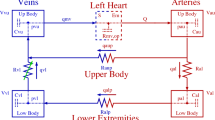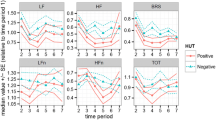Abstract
Long periods of bed rest negatively affect the human body organs, notably the cardiovascular system. To avert these negative effects and promote functional recovery in patients dealing with prolonged bed rest, the goal is to mobilize them as early as possible while controlling and stabilizing their cardiovascular system. A robotic tilt table allows early mobilization by modulating body inclination, automated passive leg exercise, and the intensity of functional electrical stimulation applied to leg muscles (inputs). These inputs are used to control the cardiovascular variables heart rate (HR), and systolic and diastolic blood pressures (sBP, dBP) (outputs). To enhance the design of the closed-loop cardiovascular biofeedback controller, we investigated a subject-specific multi-input multi-output (MIMO) black-box model describing the relationship between the inputs and outputs. For identification of the linear part of the system, two popular linear model structures—the autoregressive model with exogenous input and the output error model—are examined and compared. The estimation algorithm is tested in simulation and then used in four study protocols with ten healthy participants to estimate transfer functions of HR, sBP and dBP to the inputs. The results show that only the HR transfer functions to inclination input can explain the variance in the data to a reasonable extent (on average 69.8%). As in the other input types, the responses are nonlinear; the models are either not reliable or explain only a negligible amount of the observed variance. Analysis of both, the nonlinearities and the occasionally occurring zero-crossings, is necessary before designing an appropriate MIMO controller for mobilization of bedridden patients.






Similar content being viewed by others
References
Adami A, Pizzinelli P, Bringard A, Capelli C, Malacarne M, Lucini D, Simunič B, Pišot R, Ferretti G (2013) Cardiovascular re-adjustments and baroreflex response during clinical reambulation procedure at the end of 35-day bed rest in humans. Appl Physiol Nutr Metab 38(6):673–680
Bai EW (2004) Decoupling the linear and nonlinear parts in Hammerstein model identification. Automatica 40(4):671–676
Bamford J, Dennis M, Sandercock P, Burn J, Warlow C (1990) The frequency, causes and timing of death within 30 days of a first stroke: the Oxfordshire Community Stroke Project. J Neurol Neurosurg Psychiatry 53(10):824–829
Bernhardt P, Mertelmeier T, Hoheisel M (2006) X-ray spectrum optimization of full-field digital mammography: simulation and phantom study. Med Phys 33(11):4337–4349
Billings SA (2013) Nonlinear system identification: NARMAX methods in the time, frequency, and spatio-temporal domains. Wiley, Hoboken
Bishop CM et al (2006) Pattern recognition and machine learning, vol 1. Springer, New York
Bourdin G, Barbier J, Burlem JF, Durante G, Passant S, Vincent B, Badet M, Bayle F, Richard JC, Guérin C (2010) The feasibility of early physical activity in intensive care unit patients: a prospective observational one-center study. Respir Care 55(4):400–407
Brower RG (2009) Consequences of bed rest. Crit Care Med 37(10):S422–S428
Burtin C, Clerckx B, Robbeets C, Ferdinande P, Langer D, Troosters T, Hermans G, Decramer M, Gosselink R (2009) Early exercise in critically ill patients enhances short-term functional recovery. Crit Care Med 37(9):2499–2505
Chi L, Masani K, Miyatani M, Thrasher TA, Johnston KW, Mardimae A, Kessler C, Fisher JA, Popovic MR (2008) Cardiovascular response to functional electrical stimulation and dynamic tilt table therapy to improve orthostatic tolerance. J Electromyogr Kinesiol 18(6):900–907
Colombo G, Schreier R, Mayr A, Plewa H, Rupp R (2005) Novel tilt table with integrated robotic stepping mechanism: design principles and clinical application. In: 9th international conference on rehabilitation robotics, 2005. ICORR 2005. IEEE, pp. 227–230
Cooper N, Forrest K, Cramp P (2008) Essential guide to acute care. Wiley, Hoboken
Cooper R, Fletcher-Shaw TL, Robertson RN et al (1998) Model reference adaptive control of heart rate during wheelchair ergometry. IEEE Trans Control Syst Technol 6(4):507–514
Corno M, Giani P, Tanelli M, Savaresi SM (2015) Human-in-the-loop bicycle control via active heart rate regulation. IEEE Trans Control Syst Technol 23(3):1029–1040
Craven CTD, Gollee H, Coupaud S, Allan DB (2013) Investigation of robotic-assisted tilt-table therapy for early-stage spinal cord injury rehabilitation. J Rehabil Res Dev 50(3):367–378
Cumming TB, Thrift AG, Collier JM, Churilov L, Dewey HM, Donnan GA, Bernhardt J (2011) Very early mobilization after stroke fast-tracks return to walking further results from the phase II avert randomized controlled trial. Stroke 42(1):153–158
Czell D, Schreier R, Rupp R, Eberhard S, Colombo G, Dietz V (2004) Influence of passive leg movements on blood circulation on the tilt table in healthy adults. J Neuroeng Rehabil 1(1):4
Dittmer D, Teasell R (1993) Complications of immobilization and bed rest. part 1: musculoskeletal and cardiovascular complications. Can Fam Physician 39:1428
Fortney SM, Schneider VS, Greenleaf JE (1996) The physiology of bed rest. In: Comprehensive physiology, Wiley. doi:10.1002/cphy.cp040239
Graham GM, Thrasher TA, Popovic MR (2006) The effect of random modulation of functional electrical stimulation parameters on muscle fatigue. IEEE Trans Neural Syst Rehabil Eng 14(1):38
Hahn JO, Dumont G, Ansermino JM et al (2012) System identification and closed-loop control of end-tidal co in mechanically ventilated patients. IEEE Trans Inf Technol Biomed 16(6):1176–1184
Hainsworth R, Al-Shamma Y (1988) Cardiovascular responses to upright tilting in healthy subjects. Clin Sci 74(Pt 1):17–22
Hunt K, Allan D (2009) A stochastic Hammerstein model for control of oxygen uptake during robotics-assisted gait. Int J Adapt Control Signal Process 23(5):472–484
Hunt KJ, Munih M, Donaldson Nd, Barr F et al (1998) Investigation of the Hammerstein hypothesis in the modeling of electrically stimulated muscle. IEEE Trans Biomed Eng 45(8):998–1009
Lee DS, Lemieux T (2009) Regression discontinuity designs in economics. Tech. rep, National Bureau of Economic Research
Leontaritis I, Billings S (1987) Experimental design and identifiability for non-linear systems. Int J Syst Sci 18(1):189–202
Ljung L (1998) System identification. Springer, Berlin
Luther MS, Krewer C, Müller F, Koenig E (2008) Comparison of orthostatic reactions of patients still unconscious within the first three months of brain injury on a tilt table with and without integrated stepping. a prospective, randomized crossover pilot trial. Clin Rehabil 22(12):1034–1041
Matalon SV, Farhi LE (1979) Cardiopulmonary readjustments in passive tilt. J Appl Physiol 47(3):503–507
Menard S (2000) Coefficients of determination for multiple logistic regression analysis. Am Stat 54(1):17–24
Morris PE (2007) Moving our critically ill patients: mobility barriers and benefits. Crit Care Clin 23(1):1–20
Narendra KS, Annaswamy AM (1987) Persistent excitation in adaptive systems. Int J Control 45(1):127–160
Parati G, Saul JP, Di Rienzo M, Mancia G (1995) Spectral analysis of blood pressure and heart rate variability in evaluating cardiovascular regulation a critical appraisal. Hypertension 25(6):1276–1286
Riener R, Fuhr T (1998) Patient-driven control of FES-supported standing up: a simulation study. IEEE Trans Rehabil Eng 6(2):113–124
Sarabadani A, Bernasconi S, Klamroth-Marganska V, Nussbaumer S, Riener R (2013) Model-free predictive control of human heart rate and blood pressure. In: IEEE 13th international conference on bioinformatics and bioengineering (BIBE). IEEE, pp 1–5
Sarabadani Tafreshi A, Klamroth-Marganska V, Nussbaumer S, Riener R (2015) Real-time closed-loop control of human heart rate and blood pressure. IEEE Trans Biomed Eng 62(5):1434–1442
Sarabadani Tafreshi A, Riener R, Klamroth-Marganska V (2016) Distinctive steady-state heart rate and blood pressure responses to passive robotic leg exercise and functional electrical stimulation during head-up tilt. Front Physiol 7:612
Schwartz CE, Stewart JM (2012) The arterial baroreflex resets with orthostasis. Front Physiol 3:461. doi:10.3389/fphys.2012.00461
Siegel S (1956) Nonparametric statistics for the behavioral sciences. McGraw-Hill, New York, US, p 312. http://lib.ugent.be/catalog/rug01:000005357
Smith JJ, Porth CM, Erickson M (1994) Hemodynamic response to the upright posture. J Clin Pharmacol 34(5):375–386
Smith JO (2007) Introduction to digital filters: with audio applications, vol 2. W3K Publishing. http://www.w3k.org/books/
Su SW, Huang S, Wang L, Celler BG, Savkin AV, Guo Y, Cheng TM (2010) Optimizing heart rate regulation for safe exercise. Ann Biomed Eng 38(3):758–768
Su SW, Wang L, Celler BG, Savkin AV, Guo Y (2007) Identification and control for heart rate regulation during treadmill exercise. IEEE Trans Biomed Eng 54(7):1238–1246
Toska K, Walløe L (2002) Dynamic time course of hemodynamic responses after passive head-up tilt and tilt back to supine position. J Appl Physiol 92(4):1671–1676
Wieser M, Gisler S, Sarabadani A, Ruest RM, Buetler L, Vallery H, Klamroth-Marganska V, Hund-Georgiadis M, Felder M, Schoenberger JL et al (2014) Cardiovascular control and stabilization via inclination and mobilization during bed rest. Med Biol Eng Comput 52(1):53–64
Wieser M, Haefeli J, Bütler L, Jäncke L, Riener R, Koeneke S (2010) Temporal and spatial patterns of cortical activation during assisted lower limb movement. Exp Brain Res 203(1):181–191
Yoshida T, Masani K, Sayenko DG, Miyatani M, Fisher JA, Popovic MR (2013) Cardiovascular response of individuals with spinal cord injury to dynamic functional electrical stimulation under orthostatic stress. IEEE Trans Neural Syst Rehabil Eng 21(1):37–46
Acknowledgements
We thank Prof. Dr. Kenneth J. Hunt, Bern University of Applied Sciences for his invaluable advice, Francesco Crivelli for fruitful discussions, Maya I. Kamber for the preparation of the ethics documents, as well as Marcello Chiarello and Silvio Nussbaumer for their experimental support. This work was supported by the Commission for Technology and Innovation CTI, Switzerland, and the European Community’s Seventh Framework Programme FP7/2007-2013 under Grant Agreement No. 312815-STAMAS
Author information
Authors and Affiliations
Corresponding author
Electronic supplementary material
Below is the link to the electronic supplementary material.
Rights and permissions
About this article
Cite this article
Sarabadani Tafreshi, A., Okle, J., Klamroth-Marganska, V. et al. Modeling the effect of tilting, passive leg exercise, and functional electrical stimulation on the human cardiovascular system. Med Biol Eng Comput 55, 1693–1708 (2017). https://doi.org/10.1007/s11517-017-1628-8
Received:
Accepted:
Published:
Issue Date:
DOI: https://doi.org/10.1007/s11517-017-1628-8




